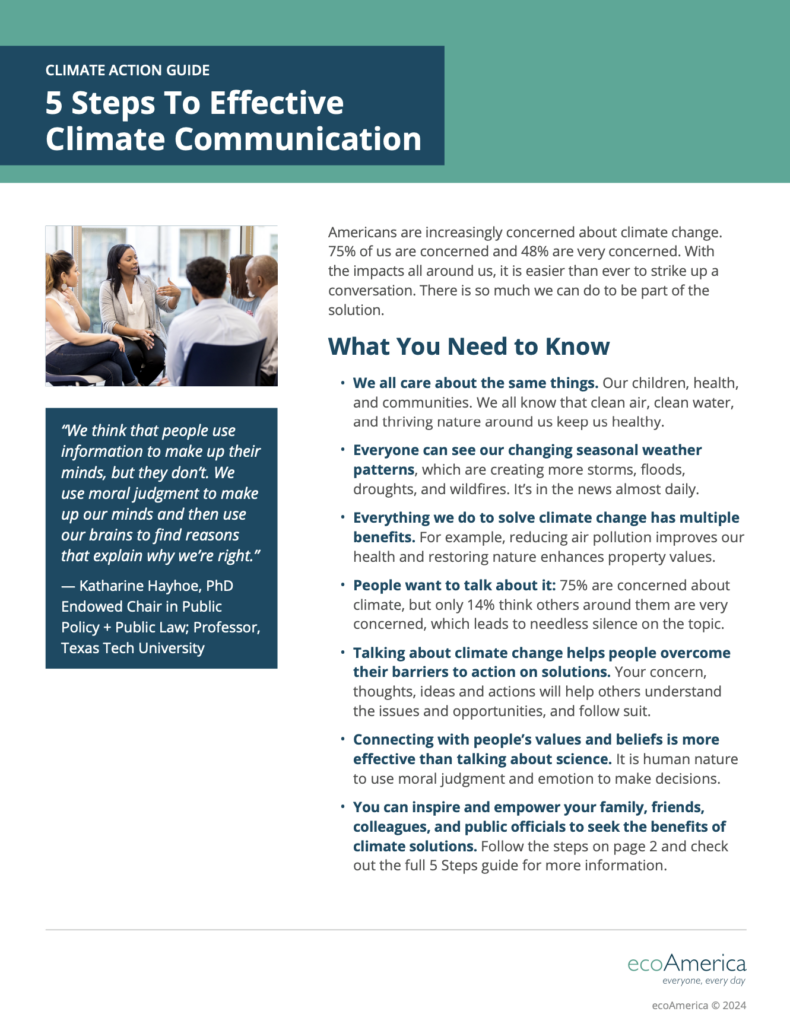
What You Need To Know
Americans are increasingly concerned about climate change. 75% of us are concerned and 48% are very concerned. With the impacts all around us, it is easier than ever to strike up a conversation. There is so much we can do to be part of the solution.
- We all care about the same things. Our children, health, and communities. We all know that clean air, clean water, and thriving nature around us keep us healthy.
- Everyone can see our changing seasonal weather patterns, which are creating more storms, floods, droughts, and wildfires. It’s in the news almost daily.
- Everything we do to solve climate change has multiple benefits. For example, reducing air pollution improves our health and restoring nature enhances property values.
- People want to talk about it: 75% are concerned about climate, but only 14% think others around them are very concerned, which leads to needless silence on the topic.
- Talking about climate change helps people overcome their barriers to action on solutions. Your concern, thoughts, ideas and actions will help others understand the issues and opportunities, and follow suit.
- Connecting with people’s values and beliefs is more effective than talking about science. It is human nature to use moral judgment and emotion to make decisions.
- You can inspire and empower your family, friends, colleagues, and public officials to seek the benefits of climate solutions. Follow the steps on page 2 and check out the full 5 Steps guide for more information.
What You Need To Do
Following are the 5 steps to crafting emotionally resonant, personalized, and effective messages on climate change.
- Start with people, stay with people. If you want people to care about climate change, care about them. Listen. Start by honoring their concerns and values, such as family, community, health, and fairness. Move from people to climate. Make room for ambivalence with a simple statement like “some of us are more worried about climate change than others” to inspire people to engage with an open mind.
- Make it real. Focus on local realities everyone can see with their own eyes, like changing seasons. Include a memorable fact or two from a trusted source. Bring forward your own climate journey to personalize the issue. Stories sell, numbers numb.
- Focus on solutions and personal benefit. Many people don’t realize that power plants are shifting from coal to solar, wind, and batteries — and it costs less. The best new cars and trucks coming from GM and Ford are electric. It’s not about sacrifice. Solutions are here, and they save money, create good jobs, clean our air, and protect our health and communities.
- Inspire and empower. We need to move Americans from concern to action on climate. We’re told we can’t make a difference on climate change when the opposite is true. Every day, almost everything you do — driving, eating, talking — can impact the problem and the people around you. So, ditch the doom and gloom. America can lead on climate solutions, and so can your state, town, family, and you!
- Be thoughtful when talking about climate change. Give examples, ideas, and steps they can take that are meaningful, accessible, and relevant. Be sure to stay above the fray and don’t get caught in the trap of arguing to refute false information. Keep it simple, big picture, and on what is important. End with your “ask,” encouraging your audience to act on climate.
“The biggest problem is not the people who aren’t on board; the biggest problem is the people who don’t know what to do. And if we don’t know what to do, we do nothing.”
— Katharine Hayhoe, PhD Endowed Chair in Public Policy + Public Law; Professor, Texas Tech University

“We think that people use information to make up their minds, but they don’t. We
use moral judgment to make up our minds and then use our brains to find reasons that explain why we’re right.”
— Katharine Hayhoe, PhD Endowed Chair in Public Policy + Public Law; Professor, Texas Tech University

